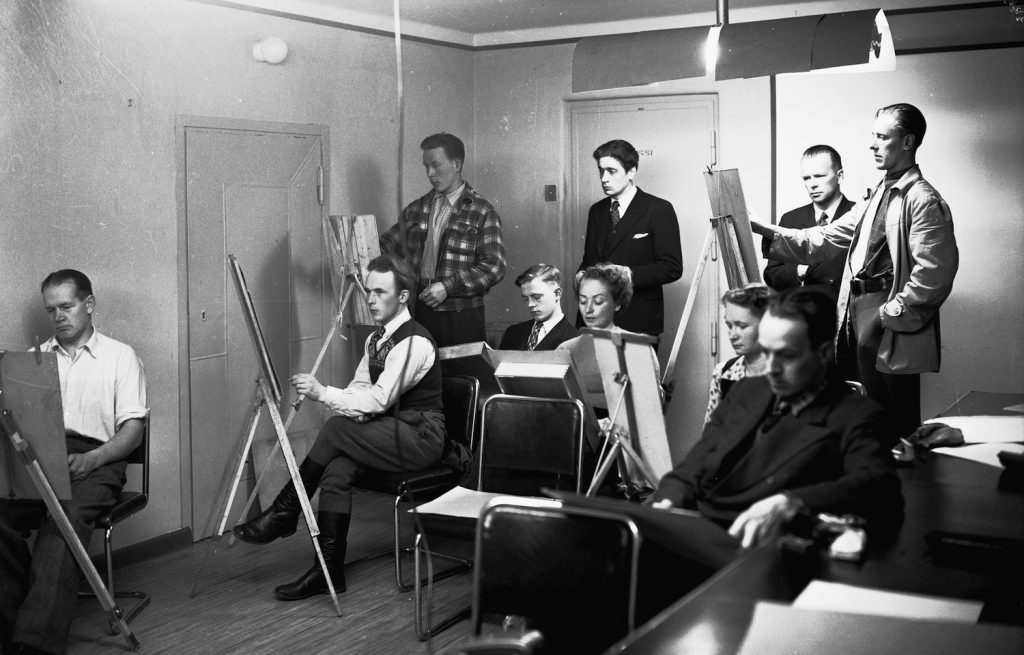Visual arts as a hobby began in Mänttä after the Second World War
AUGUST 2017
Founded in 1952, Mänttä Art Society celebrates its 65th anniversary this year. Its history is filled with new learning, thousands of drawing and painting evenings, weekend and summer camps, joint and solo exhibition exhibitions, trips in Finland and abroad, and the organisation of touring exhibitions in the local community.
In the locality, visual arts as a hobby originated after the Second World War. The first art enthusiasts gathered together on the boundary of the present Mänttä-Vilppula and Keuruu, in Kolho, which was known for its carpentry industry. The Kolho Art Club was founded there in 1948. The club may never have been officially registered. The aim of the club was to make art known in the homes of the industrial community. The chairman of the club was the local sawmill engineer V. Lybeck and the deputy chairman was interior architect T. Stenlund.
Around three years later, G. A. Serlachius Oy’s personnel magazine Tehdas ja Me reports how visual arts as a hobby had taken root in Mänttä. Included in the article is a photograph, which later came from G.A. Serlachius Oy to the museum’s photograph collection, depicting six men and two women drawing a live model in a windowless cellar room of G. A. Serlachius Oy’s head office building, nowadays the basement of Gustaf Museum. Also shown is a visiting teacher, the painter Unto Liettyä from Ruovesi, and next to him, standing behind on the right, the father of Mänttä’s drawing and painting as a hobby, Viljo Pyykkö, the department manager for social affairs.
Viljo Pyykkö (1910–1997) had come to Mänttä from Jyväskylä in autumn 1948, from G. A. Serlachius Oy’s Kangas paper mill. In addition to the Jyväskylä Artists’ Association, the Jyväskylä Art Club was founded in the late 1940s. The club organised, among other events, the nationally significant Putkilahti and Korpilahti painting camps between 1948 and 1957. Their host and organiser was the artist Helmer Selin, with whom Pyykkö had become acquainted during his own studies at Putkilahti.
After the war, Mänttä’s first local art exhibition was held in 1949 at the Mänttä Club, featuring a mill workers’ art and crafts (puhdetyö) exhibition and related drawings and paintings. This exhibition and Helmer Selin’s inspiring example encouraged Pyykkö to establish, on 14 December 1950, an art club in basement of G. A. Serlachius’ head office. Activities were launched immediately at the beginning of the following year. Mänttä Art Club’s rules and name were confirmed in February 1952 and the club was registered in September the same year.
The purpose of the club was to maintain and develop its members’ visual arts hobby, to undertake visual arts education and to promote the visual arts. In the early years, G. A. Serlachius Oy supported the club by providing, free of charge, meeting rooms, heat, electricity and by paying the fees of guest teachers such as Unto Liettyä, Helmer Selin and Nandor Mikola. The mill also donated drawing paper to the club.
Later, in the 1950s, the art club members were taught by the painter Jorma-Tapio Valkama, from Jämsä, and in the mid-1960s by the sculptor Raimo Heino, who lived in Mänttä. In the 1960s, the art club moved from the basement of the mill’s head office to work in the gymnasium of the mill’s Vocational School and later to the decoration class of the Commercial College.
Mänttä Art Club organised annual exhibitions, and the club members also held their own exhibitions. The exhibition premises included Mänttä Club, the reception hall of the Vocational School and the lower lobby of the Savings Bank. Camps were held in the summer and on weekends, one of them being in Joenniemi in summer 1976. The club members also learned about the visual arts by studying works in Joenniemi and by making presentations about them. Trips to art exhibitions were made in Finland and abroad.
The club operated under the name Mänttä Art Club (Mäntän Taidekerho) until 1977. Nowadays, it is known by the name Mänttä Art Society (Mäntän Taideseura). In 1961, Viljo Pyykkö designed the Mänttä Art Club’s emblem, which features a heart-shaped palette. Its idea is based on the trinity “heart – 3 tone – palette”.
Many local and regional visual arts associations still operating in Finland were founded just after the war, when there was a longing for togetherness and new learning after the bleak war years. In Finland, municipal cultural activities started up in the late 1960s. For example, the Mänttä township gained a Cultural Board in 1967 and an Arts Ombudsman two years later.
Before the start of municipal cultural activities, many volunteer organisations engaged in arranging local cultural services. Mänttä Art Club received, hung and supervised, for example, touring exhibitions of works from the Exhibition and Information Department of the Fine Arts Academy of Finland, nowadays the Finnish National Gallery (Ateneum), of which the first, From Edelfelt to Sallinen, opened in the Mänttä Club in 1952. In 1963, the exhibition was Paris Masters, featuring works by Matisse, Picasso and Miro, among others. In the late 1960s, there was also cooperation with Gösta Serlachius Fine Arts Foundation, when the programme for 1968 included Master Works of Times Past, a touring exhibition of the Exhibition and Information Department of the Fine Arts Academy of Finland.
Marjo-Riitta Simpanen
Researcher, Art Historian


